The Economist is a well-known and quite prestigious London-based weekly news magazine, founded in 1843 by James Wilson, a Scottish businessman, economist and politician. It claims an average weekly circulation of 1.5 million in 2006, about half of which were sold in the United States.
The publication belongs to The Economist Group, half of which is owned by Pearson PLC via the Financial Times. The other half is owned by a group of independent shareholders, including the Rothschild banking family of England.
That the Rothchilds own part of The Economist accounts for why Vigilant Citizen (VC), the blogger who specializes in analyzing pop culture symbols and their hidden meanings, gives import to the magazine’s disquieting “The World in 2015″ cover with a mushroom cloud from a nuclear bomb explosion, among other disturbing images. In VC’s words:
It [The Economist] is partly owned by the Rothschild banking family of England and its editor-in-chief, John Micklethwait, attended several times to the Bilderberg Conference – the secretive meeting where the world’s most powerful figures from the world of politics, finance business and media discuss global policies. The outcome of those meetings is totally secret. It is therefore safe to say that the people at The Economist know things that most people don’t.
Here is The Economist‘s 2015 cover (click to enlarge), followed by an analysis.
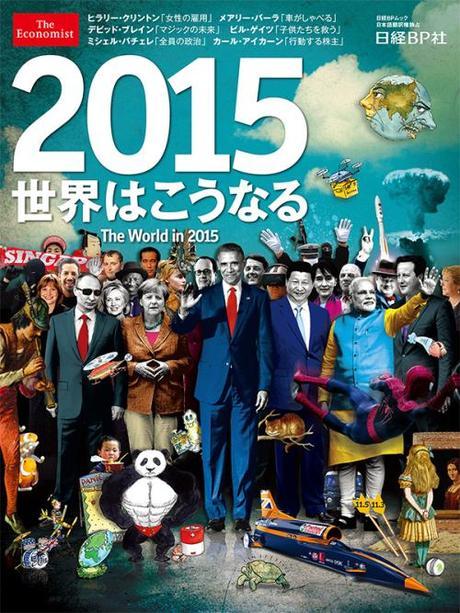
To begin, The Economist‘s 2015 cover is reminiscent of the eerie image on the album cover of The Beatles’ Sgt. Pepper’s Lonely Hearts Club Band (see below), which was a color photo taken in a studio of the four Beatles wearing band uniforms, surrounded by life-size cardboard cutouts of themselves in suits, as well as those of famous personalities, both living and dead.
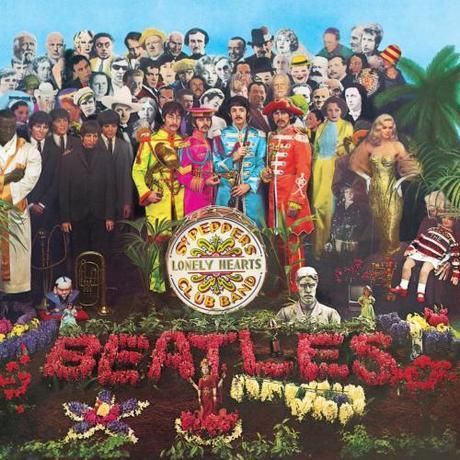
The Beatles, of course, are in color, as are some of the cardboard figures, while other figures are in black and white (b&w). There doesn’t seem to be a discernible reason for why some are in b&w because they include people both dead (e.g., Karl Marx) and alive (e.g., Bob Dylan).
Black & White Faces
The Economist‘s “The World in 2015″ cover also has various figures in color and b&w, with one difference — only the heads and faces of some are in b&w, while their bodies are in color, which gives their faces a sinister drained-of-blood walking-dead quality. The b&w heads are a majority, and they include both the living (Barack Obama) and the dead (Winston Churchill). Vigilant Citizen thinks that “those in black and white appear to be part of the elite (including the ISIS guy who probably works for them) and those in color are “outsiders”. Is this how the elite perceives the world?”
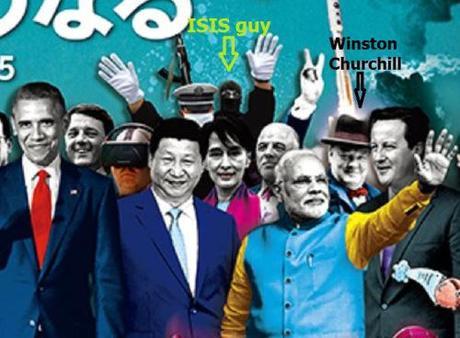
The Pied Piper

VC writes:
“The presence of the Pied Piper on this 2015-themed cover is downright unsettling. The Pied Piper of Hamelin is a German legend about a man who used his magical flute to lure away the children of the city of Hamelin, never to be seen again.
This folkloric figure dating from the Middle-Ages is said to represent either massive death by plague or catastrophe, or a movement of massive immigration. It also perfectly represents today’s youth being ‘lured’ and mystified by the ‘music’ of mass media. Conveniently enough, there’s a small boy right under the Piper’s flute.”
To reinforce the message of pop music’s allure and deception, there’s a drum set beneath the clueless little boy. One drum has stars and stripes (signifying American pop music); another is inscribed with “50th,” meaning what?
Game of Panic
VC writes: “Right under the Pied Piper we see a young boy with dumbfounded look on his face. He is watching a game called ‘Panic’. The words ‘Federal Reserve’ and ‘Chi’ (which probably stands for China) are on top while the words ‘Green light!’ and ‘sis!’ (which probably stands for ‘Isis!’ or ‘Crisis!’) are at the bottom. The little boy watches as this twisted game of Plinko unfolds the same way the clueless masses watch powerlessly while various events unfold on mass media. As the name of the game states, the ultimate goal is to cause Panic around the world as crises are almost randomly generated by those who control the game. And that’s on a magazine cover owned by the Rothschilds.”
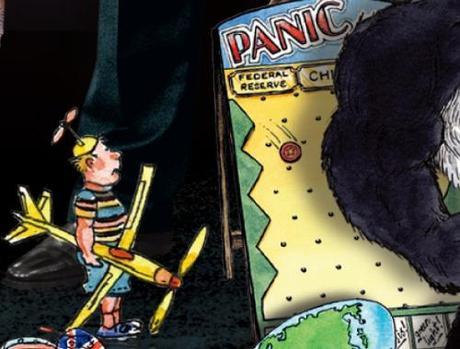
Crop Duster
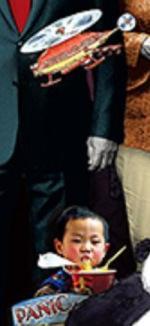
In front of a sinister-looking Russian president Vladimir Putin is a small helicopter on which is written Crop-O-Dust — a reference to crop dusting, “the process of spraying crops with powdered insecticides or fungicides from an aircraft.”
Right under the helicopter is an Asian kid, eating processed noodles.
And below the kid is “PANIC”!
.
CHINA
Next to the noodle-eating Chinese kid is a panda on steroids, wearing a China-flag Speedo while flexing its muscles — a clear reference to China gaining power. The panda dwarfs a sumo wrestler, signifying the eclipse of Japan by China.
The sumo wrestler holds an out-sized battery on which the polarities (+ and -) are clearly indicated. VC wonders if that’s a symbol for a switch in polarity in world power from the West to the East?
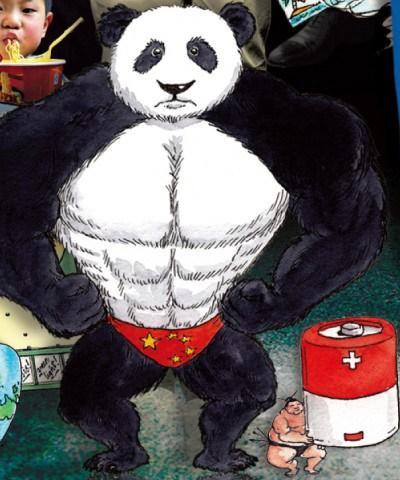
GHOST ON HOLIDAY
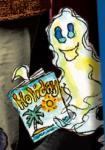
VC writes: “Emerging from behind Obama’s leg is a ghost reading a magazine entitled ‘Holiday’. Why is this ghost, which represents a dead person, planning a vacation? Does it represent the fact that the masses will be so impoverished that the only time they’ll be on a holiday is when they’re dead? Does it relate to the countless people who died while traveling in the past months? Creepy.”
TURTLE

VC writes: “Standing in front of everything else, gazing right into our souls is a turtle with emphasis lines around its shell. What does it represent? Will turtles make a huge comeback in 2015? Probably 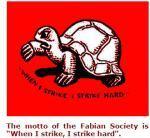 not.
not.
An angry tortoise is the symbol of the Fabian Society, an extremely powerful organization that has been working for over a century towards the formation of a single world government. The 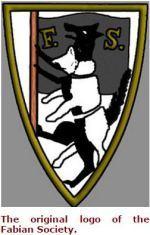 philosophy behind Fabian socialism is basically the blueprint of what we call today the New World Order…..
philosophy behind Fabian socialism is basically the blueprint of what we call today the New World Order…..
The Fabian Society used to openly advocate a scientifically planned society and supported eugenics by way of sterilization. Its original logo was a wolf in sheep’s clothing … But I guess that was not the best way to conceal the wolf from the masses. [A turtle is so much better!]
Bringing forth a global system through small incremental changes is exactly what the world elite is currently doing.”
11.3 and 11.5
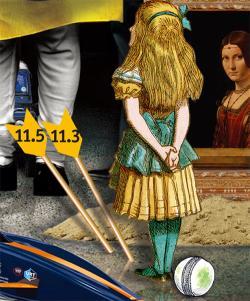
VC writes: “The lower right side of the cover features some more cryptic symbols. There’s a pile of dirt on the ground and two arrows on which are inscribed 11.5 and 11.3. Are those dates to remember? Why are they next to a pile of dirt? If you look up these figures as coordinates, they point to somewhere in Nigeria. Displaying numbers that can only be truly understood by ‘those in the know’ is one of the occult elite’s favorite hobbies.”
Alice in Wonderland & the Cheshire Cat
Standing to the right of the 11.5 (November 5?) and 11.3 (November 3?) arrows is Alice in Wonderland, who’s looking up at the Cheshire Cat on a tree branch. VC writes: “This iconic cat is known for disappearing entirely, leaving only visible its creepy grin. We therefore see another allusion to a world of fantasy, illusion and deceit as perceived by Alice – a representative of the masses. Along with the somewhat unnecessary inclusion of David Blaine – a magician – the cover mixes real world events with illusions.”
Note that the tree branch is coming from Obama’s leg — the man of fantasy, illusion, and lies.
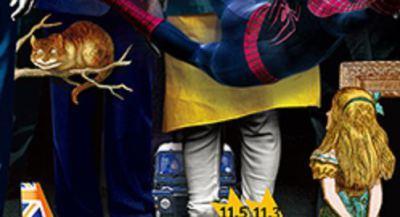
The Lady with No Ermine
To the right of Alice is a portrait that’s a reverse image of Leonardo da Vinci’s painting, The Lady with an Ermine (1489-1490), but without the ermine.
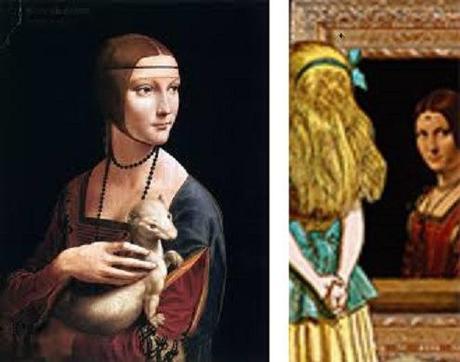 Leonardo da Vinci’s Lady with an Ermine (l); Economist 2015 cover’s lady without an ermine (r)
Leonardo da Vinci’s Lady with an Ermine (l); Economist 2015 cover’s lady without an ermine (r)
The subject of da Vinci’s portrait is Cecilia Gallerani, the mistress of Ludovico Sforza, Duke of Milan, who was the painter’s patron. Ermines, aka stoats, are known for their purity.
There are other images in the Economist’s 2015 cover like the two-faced globe, the blonde woman with a strange head-dress, and the strange thing (a piggy bank?) coming out of UK Prime Minister David Cameron’s suit jacket.
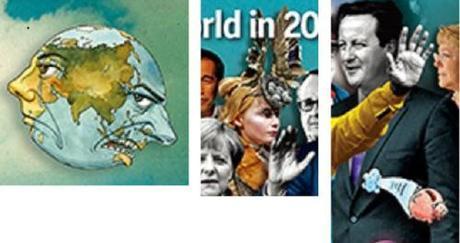
Whatever the image, know that it’s there for a reason. The Economist had commissioned an artist to put together its “World in 2015″ cover, which means time and thought went into it. The images were selected for a reason, and each has an esoteric meaning known to The Economist, but cryptic to the rest of us.
See also:
- The Satanic Rothschild
- Bilderberg meets to decide US presidential election
- Secretive Bilderberg global elite meet in England
- 2014 Bilderberg Guest List
- Is the Bilderberg group grooming a new messiah?
- Powerful Bilderberg Group’s Tax Returns
~Eowyn

